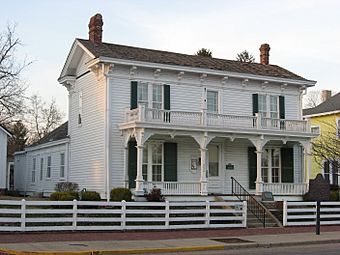Riley Birthplace and Museum facts for kids
Quick facts for kids |
|
|
James Whitcomb Riley House
|
|

Front and western side of the house
|
|
| Location | 250 W. Main St., Greenfield, Indiana |
|---|---|
| Area | less than one acre |
| Built | 1847 |
| Architect | Riley, A. Reuben |
| Architectural style | Italian Villa |
| NRHP reference No. | 77000017 |
| Added to NRHP | September 28, 1977 |
The Riley Birthplace and Museum is a special house in Greenfield, Indiana. It's one of two homes linked to the famous poet, James Whitcomb Riley. This house is listed on the National Register of Historic Places, which means it's an important historical site. It's about twenty miles (32 km) east of Indianapolis.
Contents
The Poet's Childhood Home
This museum shows where the well-known Hoosier poet, James Whitcomb Riley, grew up. His father, Reuben Riley, built the house in 1850. Reuben was a lawyer and the first mayor of Greenfield. James Whitcomb Riley was actually born in a small cabin on the property on October 7, 1849.
Building the Family Home
Reuben Riley realized his cabin was too small for his family of five. So, he spent three years building the larger house. He even used parts of the old cabin to help build the new home. For example, the winding staircase inside the house was made from materials from the cabin.
Life on the National Road
Even though the house was on the busy National Road, it was surrounded by nature. Many woodland animals lived nearby, but there weren't many people. The front porch had two doors. One door led to the family's living room, and the other opened into Reuben Riley's law office.
Inspiration for Poems
Many people visited Reuben's law office. Young James Whitcomb Riley watched his father talk to these visitors. This helped James learn how to entertain people with stories and speeches. Some visitors, like a poor man and an orphan girl named Mary Alice Smith, inspired Riley. Mary Alice later became the character in his famous poem, "Little Orphant Annie".
Changes for the Riley Family
During the American Civil War, Reuben Riley helped organize a local militia. This took time away from his law practice, and his family faced financial struggles. Because of this, he had to sell the house in 1870. Years later, in 1893, James Whitcomb Riley bought the house back. However, he lived in Indianapolis at what is now the James Whitcomb Riley Museum Home. His brother John and John's wife lived in the Greenfield house. James often visited them, and in 1898, he called Greenfield "the best town outside of Heaven."
Riley's Legacy
Before he passed away in 1916, James Whitcomb Riley wrote over 1,000 poems. Some of his most famous works include "Little Orphant Annie", "When the Frost is on the Punkin", and "The Bear Story". During his lifetime, many people thought he was even more important than Mark Twain. The city of Greenfield bought the property in 1936. They created the Riley Old Home Society to manage it. The house was officially added to the National Register of Historic Places in 1977.
Visiting the Museum Today
The Riley home is now a museum. The Riley Old Home Society and the Greenfield Parks and Recreation Department manage it. Thousands of visitors come each year from April through November. The museum is usually closed during the winter months.
The Mitchell House and Gardens
Next to the Riley home is the Mitchell House. This was the home of John Mitchell, who published James Whitcomb Riley's poems. Today, the Mitchell House is also a museum. This allows the Riley home to be kept looking just as it did when James lived there. Visitors also enjoy the beautiful garden behind the Riley house. The Greenfield Herb Society has cared for and developed this garden since 1991.
Annual Riley Festival
Every year, Greenfield celebrates James Whitcomb Riley. An annual festival takes place from the first Thursday to Sunday in October. It honors Riley's connection to the town. The Riley house is located along the old National Road, which is now known as U.S. Route 40.



